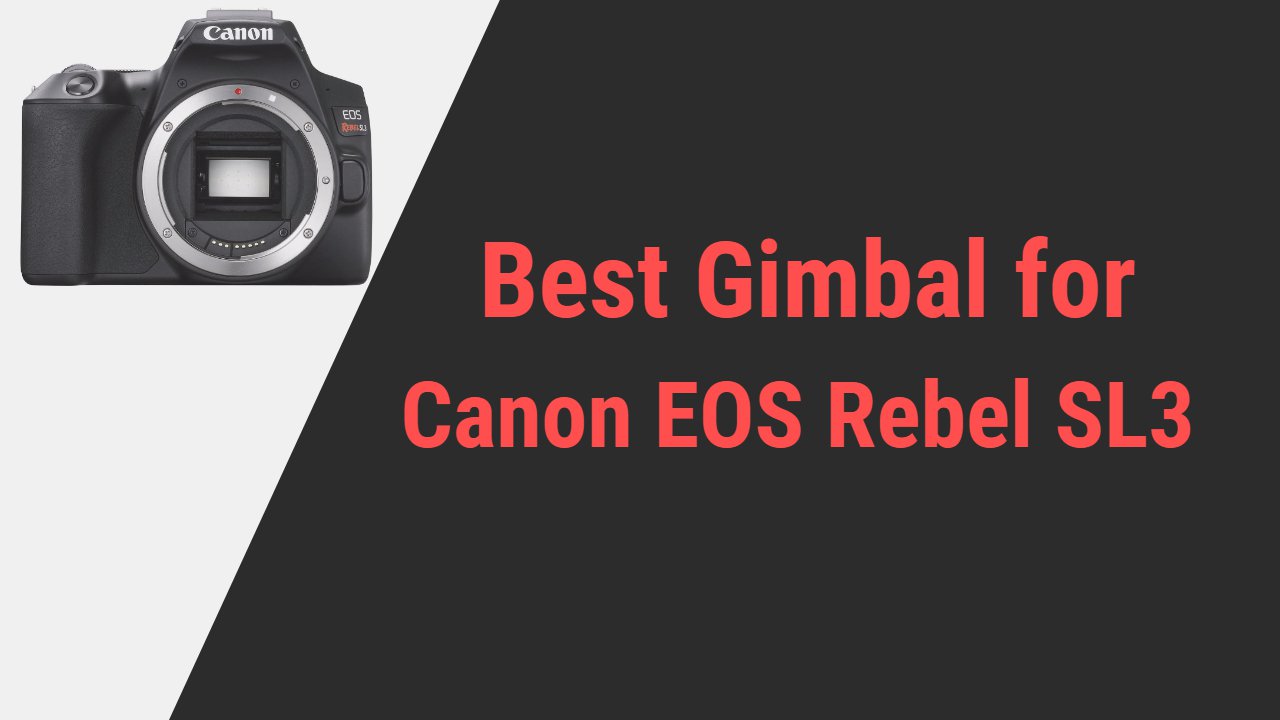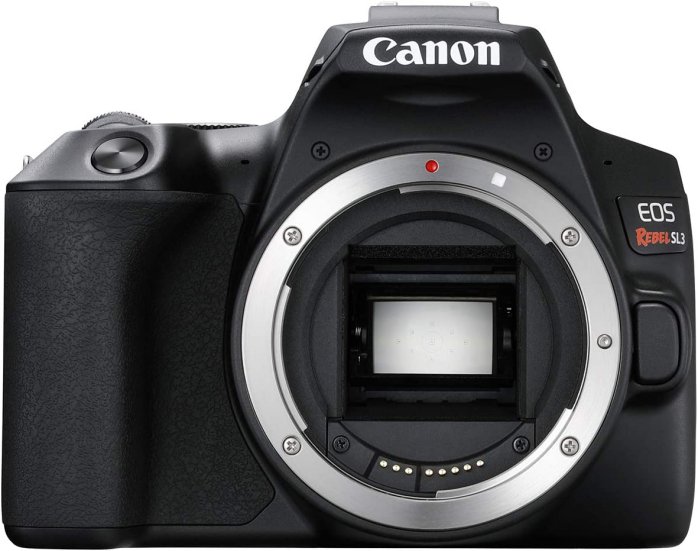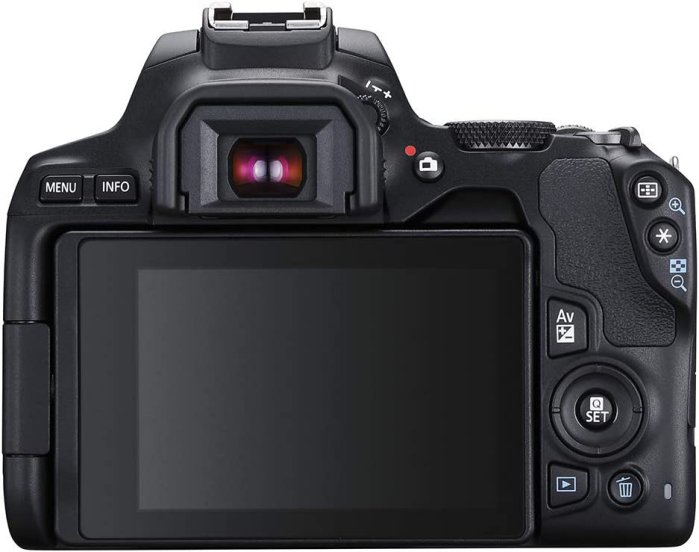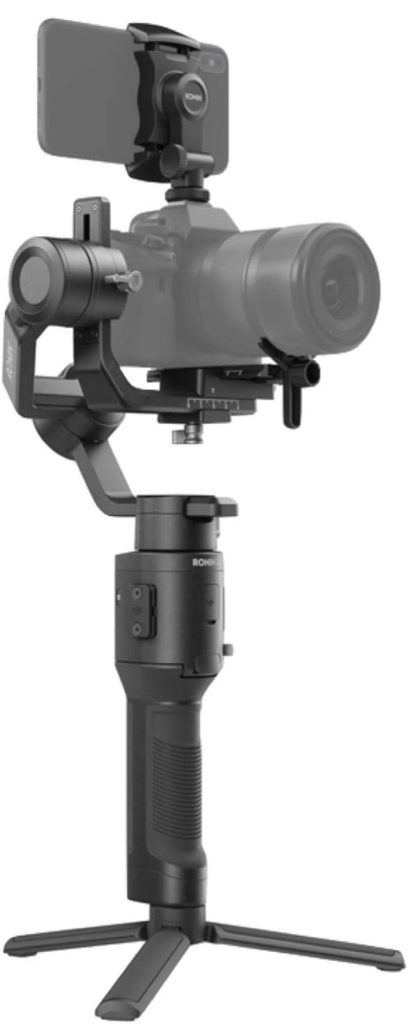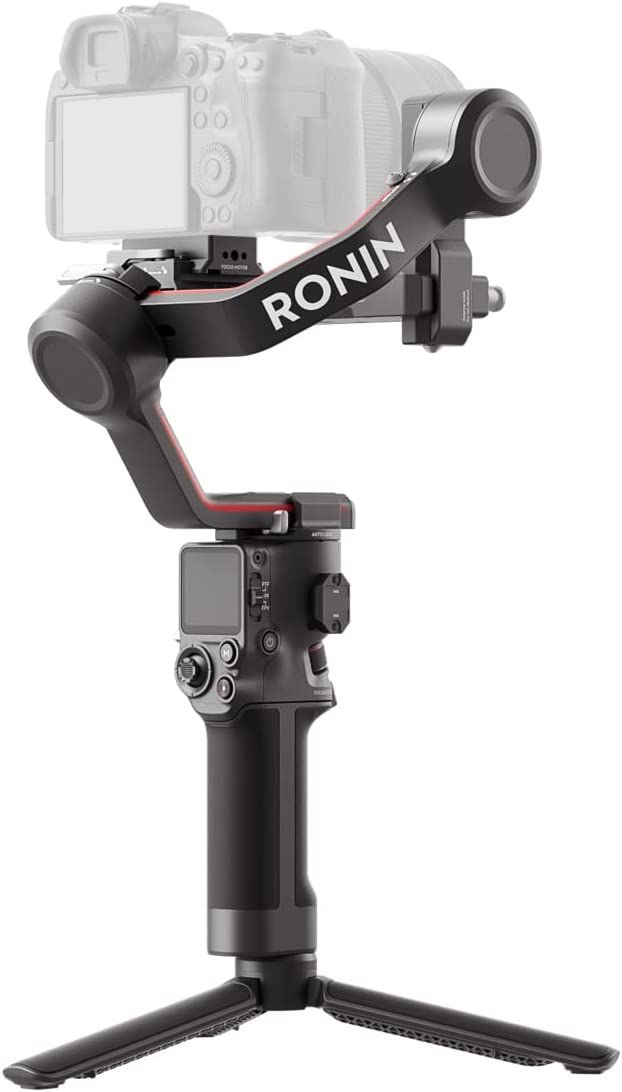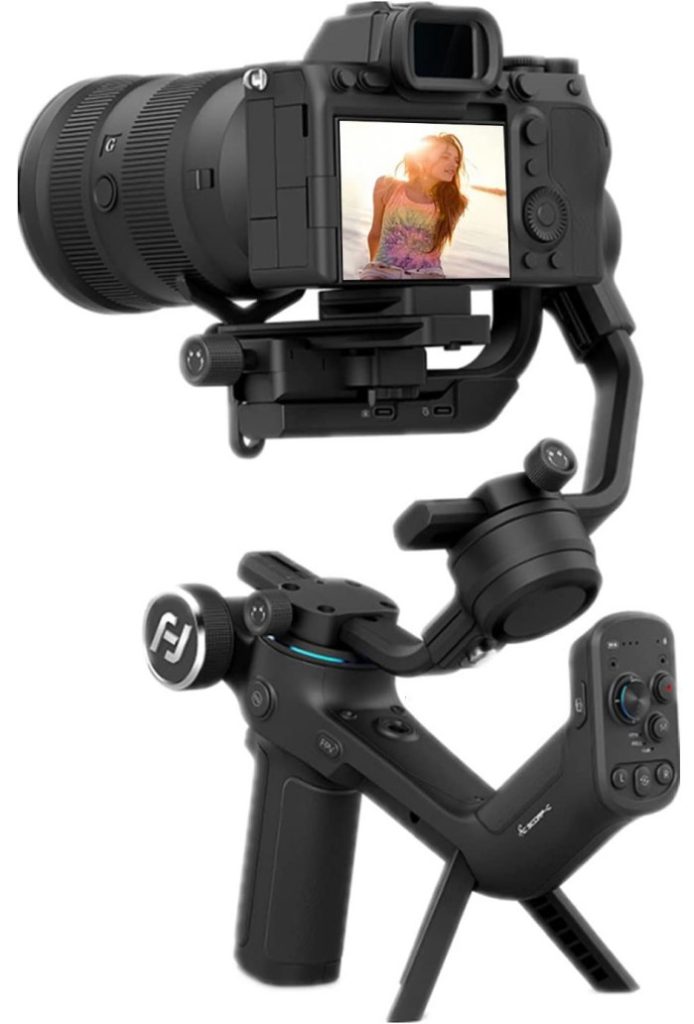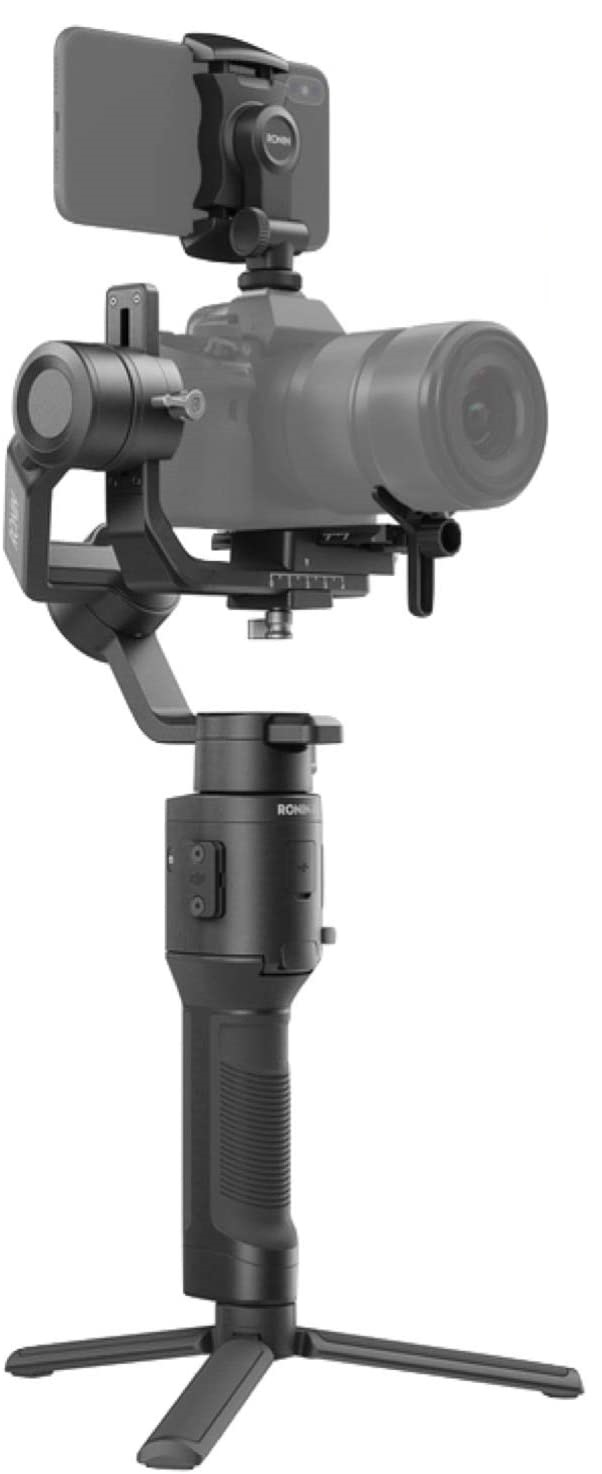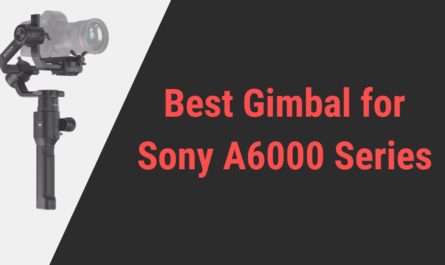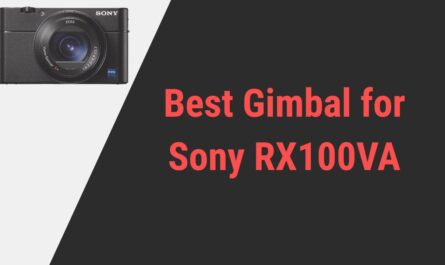The weight and size of the camera, as well as the features and controls you require, should all be taken into account when choosing the best gimbal for the Canon EOS 200D II. Given that the Canon EOS 200D II is a lightweight and small DSLR camera, a small and light gimbal would be ideal.
Additionally, gimbals with advanced stabilization, automatic object tracking, motion memory, and smartphone control. There are always so many factors that you need to consider before you end up making your purchase. We have done all the hard work for you, so you do not have to.
But before we bring you some awesome gimbals for Canon EOS Rebel SL3, let us get to know the camera first. It is also important to know that this amazing camera is also known as EOS 200D II.
Canon EOS Rebel SL3 (200D II)
Note:
All the gimbals mentioned here are tested with Canon EOS Rebel SL3 and work perfectly fine.
| DJI Ronin-SC (Best Overall)

|
| DJI RS 3 (Most High-end - Highest Payload Capacity & Comes with Advanced Features)
    |
| FeiyuTech SCORP-C (Cheapest Gimbal with Minimal Features)
    |
Canon EOS Rebel SL3 (200D II) Camera
The Canon EOS 200D II is a lightweight and compact DSLR camera that is designed for photography enthusiasts. It offers advanced features such as a 24.2 MP APS-C CMOS sensor, Dual Pixel CMOS AF, DIGIC 8 Image Processor, and 4K UHD 24p video recording.
There are so many different features that this camera has and with everything that this camera has, let us get to know about those features and why it is a really great camera. A digital SLR camera called the EOS 200D II was launched by Canon in August 2019. It is an entry-level camera and the EOS 200D’s replacement.
A 24.2-megapixel APS-C CMOS sensor, a DIGIC 8 image processor, and a Vari-angle LCD touchscreen are some of its features. Wi-Fi, Bluetooth, and NFC are also built-in for convenient connectivity and remote control. It also has Dual Pixel CMOS AF for quick and precise auto focusing when taking still photos as well as videos, and it can record 4K video.
24.2MP APS-C CMOS Sensor – This sensor is capable of capturing high-resolution images with excellent detail and color reproduction.
Dual Pixel CMOS AF – This feature allows for fast and accurate autofocus, making it easy to capture sharp and clear photos and videos.
DIGIC 8 Image Processor- This powerful processor enables fast performance and advanced image processing capabilities, such as noise reduction and high-ISO performance.
4K UHD 24p video recording – The camera is capable of capturing 4K UHD video at 24 frames per second, which is great for videographers looking to capture high-quality footage.
Vari-angle touchscreen LCD – The camera has a 3-inch variable-angle touchscreen LCD, which makes it easy to compose shots from any angle and preview images and videos.
Wi-Fi and Bluetooth connectivity – The camera offers built-in Wi-Fi and Bluetooth connectivity, which allows for easy sharing of photos and videos, as well as remote control of the camera via a smartphone app.
In addition to that, let us know the specifications of this camera,
- 24.2 megapixel APS-C CMOS sensor
- DIGIC 8 image processor
- Dual Pixel CMOS AF with 9 AF points
- ISO range of 100-25600, which is expandable to 51200
- 3″ Vari-angle touch screen LCD
- Full HD 1080p video recording at 60 fps
- Built-in Wi-Fi, Bluetooth, and NFC
- Weight of approximately 449g
- Battery life of approximately 1,200 shots per charge
- Compatible with EF/EF-S lenses
- Available lens: EF-S 18-55 IS STM, EF 75-300mm f/4-5.6 III
- It has the option to shoot in raw and jpeg format
- It has a burst mode of 5 fps
- Has a built-in flash and a hot shoe for external flash
- It has a guided user interface, making it easy for beginners to use.
By now, we are sure that you will know everything you need to know about this camera, and it is time that we can bring you to many different gimbals that you can get for this precious and high-performing camera.
Best Gimbal for Canon EOS Rebel SL3
1. DJI Ronin SC
The DJI Ronin SC is a compact and lightweight 3-axis gimbal stabilizer designed for mirrorless and DSLR cameras like the Canon EOS 200D II. It allows for smooth and stable footage when shooting in various conditions, such as when walking, running, or moving in tight spaces.
It is designed to provide smooth and stable footage while shooting in various conditions, such as walking, running, or moving in tight spaces. The gimbal has a compact and lightweight design, weighing only 1.1 kg, and can support payloads of up to 2.5 kg.
It has multiple shooting modes, such as panorama, timelapse, and motion lapse, and a max battery life of 11 hours. The gimbal also featured a built-in joystick and quick-release plate for easy control and camera attachment. It can be controlled wirelessly via Bluetooth and the DJI Ronin app.
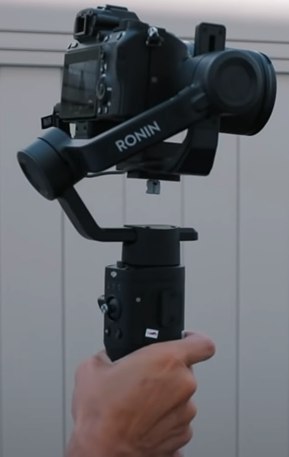

The gimbal also has a Sport mode which increases the responsiveness of the gimbal for fast-moving shots. It supports both portrait and landscape orientation and can be used with a variety of cameras, including the Canon EOS 200D II. The gimbal also has a time-lapse feature which allows you to capture time-lapse shots with ease.
The DJI Ronin SC is a popular choice for professional videographers and photographers who want a lightweight and portable option for stabilizing their shots. It is designed to work with a wide range of cameras, and it is easy to set up, operate and achieve professional results.
Some key features of the DJI Ronin SC include,
- Compact and lightweight design, weighing only 1.1 kg
- Can support payloads up to 2.5 kg
- Provides smooth and stable footage with 3-axis stabilization
- Has multiple modes, such as panorama, timelapse, and motion lapse
- Has a max battery life of 11 hours
- Has a built-in joystick and quick-release plate
- It supports wireless control via Bluetooth and the DJI Ronin app
- Has a new Sport mode which increases the responsiveness of the gimbal
- It supports both portrait and landscape orientation
- It can be used with a variety of cameras, including the Canon EOS 200D II
- It has a time-lapse feature that allows you to capture time-lapse shots with ease.
Pros
- Great build quality
- Professional results
- Comparatively quiet compact and travel-friendly
- The app is quite effective
- Good payload
Cons
- Price is one of the cons
- Requires some time for balancing
2. DJI RS 3
Among many of the latest gimbals in the market, DJI has recently launched DJI RS 3. It is a professional gimbal stabilizer for cameras made by DJI.
The RS 3 is designed for professional videographers and photographers looking for a powerful and versatile gimbal stabilizer. It’s a 3-axis gimbal that can support payloads of up to 3 kg and has a maximum battery life of 12 hours.
The DJI RS 3 is a powerful and versatile gimbal stabilizer that can support a wide range of cameras and lenses. It’s ideal for professional videographers and photographers who want a high-performance gimbal that can handle heavy payloads and provide smooth and stable shots.
It also has advanced features such as Active track 3.0, Focus Pro 2.0, and Force mobile mode, which makes it a great option for professional shoots. It is one of the reasons that the DJI RS 3 is the right gimbal for the EOS Rebel SL3.
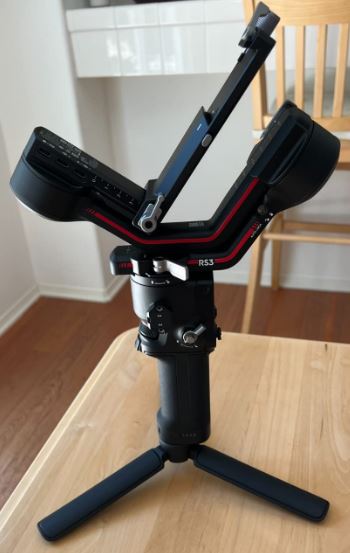

Some key features of the DJI RS 3 include,
- It has a built-in OLED screen that shows the gimbal status and parameters
- Has a new Titan Stabilization Algorithm for smooth and stable shots
- Has multiple shooting modes, such as panorama, timelapse, and motion lapse
- Has a joystick and quick-release plate for easy control
- Has a new “Force Mobile” mode that allows for smooth camera movement while walking or running
- Has a built-in power hub that supports accessories such as lights or monitors
- It has a new “Active Track 3.0” feature that tracks the subject and keeps it in the frame
- Has a new “FOCUS PRO 2.0” feature that allows for precise focus control
- Has a built-in wireless control via Bluetooth and the DJI Ronin app
Pros
- Up to 3 kg of payload
- Physical mode switch
- Great shutter results
- Easy to use touch screen
- Highly stabilized results
Cons
- Longer lenses require tough balancing
3. FeiyuTech SCORP-C
The FeiyuTech SCORP-C is a compact and versatile gimbal stabilizer that is perfect for vloggers, content creators, and amateur filmmakers.
The device is designed to work with smartphones, action cameras, and mirrorless cameras, and it offers a wide range of features that make it easy to capture smooth and stable footage.
One of the standout features of the SCORP-C is its compact and lightweight design. The device is only 7.2 inches long and weighs just over a pound, making it easy to take with you on the go. The gimbal also features a built-in rechargeable battery that provides up to 12 hours of use on a single charge.
The SCORP-C also offers a variety of shooting modes, including pan follow, lock, and full-range POV, which allows you to capture smooth and stable footage in any situation.
The gimbal also features a joystick control, which makes it easy to adjust the angle of the camera while you’re shooting.
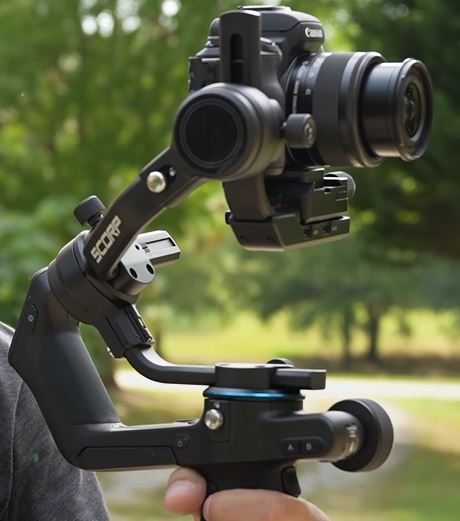

Another great feature that we like about this gimbal is that it has the ability to work with a companion app, which allows you to control the gimbal remotely and make adjustments to the camera’s settings.
The app also allows you to create time-lapse and motion-lapse videos, which can add an extra level of creativity to your footage.
Some features that will help you with great results are,
- Built-in rechargeable battery– The gimbal provides up to 12 hours of use on a single charge.
- Shooting mode– The SCORP-C offers a variety of shooting modes, including pan follows, lock, and full-range POV, which allows you to capture smooth and stable footage in any situation.
- Joystick control– The gimbal features a joystick control which makes it easy to adjust the angle of the camera while you’re shooting.
- Supports multiple devices– The gimbal is compatible with smartphones, action cameras, and mirrorless cameras.
- Multiple-axis stabilization– Provides 3-axis stabilization to eliminate unwanted camera shake and movement.
- Additional controls– The gimbal has multiple buttons and knobs for easy operation of the device and camera.
- Durable construction– The gimbal is built with high-quality materials that ensure durability and longevity.
Pros
- Easy to balance and use
- Center focus-oriented
- Fast charging capacity
- Professional looking results
- Comfortable to use
Cons
- The app could have been better
- The battery is not replaceable
Buying guide for a gimbal for Canon EOS Rebel SL3 (EOS 200D II)
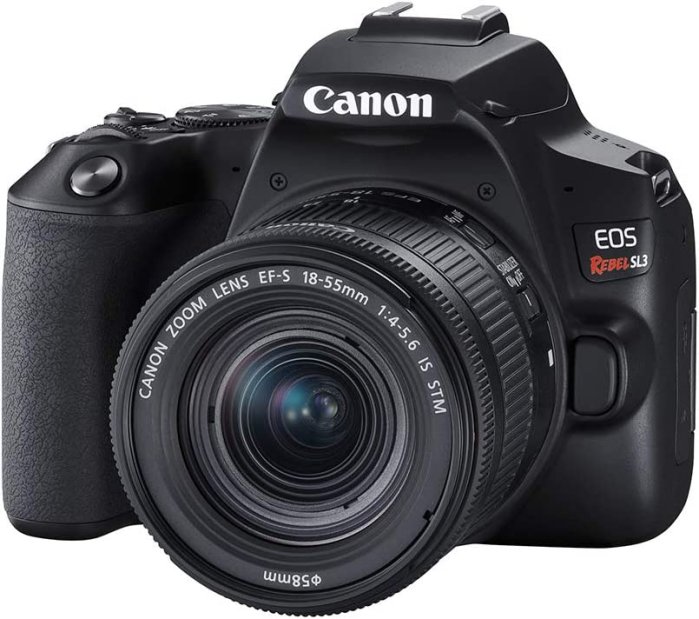

Choosing one gimbal for your camera from even three options might be a tough task as you might wonder which one can be more suitable for your needs. To ensure that even that is made easy for you, we have prepared this buying guide.
By the end of this article, you have the name of the gimbal you want to get for Canon EOS 200D II. You just have to figure out below mentioned features to make your decision,
Compatibility- Make sure the gimbal you choose is compatible with the EOS 200D II and can hold its weight and size. if the gimbal is not designed to hold the weight and size of the camera, it may not be able to provide stable and smooth footage. This can result in shaky or unstable footage that is difficult to watch.
When there is compatibility, it ensures that the camera and gimbal work together seamlessly. This means that the gimbal’s controls and settings will be designed specifically for the camera, making it easy to use and adjust settings. Incompatibility may lead to difficulty in using the gimbal or not being able to use some of the gimbal features.
If the camera and gimbal are not compatible, it can be difficult or impossible to attach the camera to the gimbal properly. This can lead to problems with stability and may even damage the camera.
Stabilization- Look for a gimbal with advanced stabilization technology that can handle the camera’s weight and provide smooth, stable footage. A gimbal with advanced stabilization technology can help to eliminate camera shake and provide smooth, stable footage. This is especially important when capturing video footage or when trying to achieve a cinematic look.
A gimbal allows you to move the camera in various directions while keeping it stable. This can provide greater versatility in your shots and help you to capture footage that would be difficult or impossible to get with a stationary camera.
In addition to all of that, the gimbal allows you to control the camera’s movements and keep it stable, which can be especially helpful when capturing footage in challenging environments like windy or low-light conditions.
Professional look- Stabilized footage can give your videos a professional look and feel. A professional look in the gimbal is important because it can help to enhance the overall quality and credibility of your footage. When people watch your videos, they are more likely to take them seriously and engage with the content if it looks polished and professional.
This can be especially important if you are producing content for clients or for your own personal brand. A gimbal with advanced stabilization technology can help to eliminate camera shake and provide smooth, stable footage. This can give your videos a cinematic look and feel, making them appear more polished and professional.
Battery life- Consider the battery life of the gimbal and whether it can be easily charged or replaced. Battery life is important when choosing a gimbal because it determines how long you can use the gimbal before needing to recharge or replace the battery.
A gimbal with a short battery life may not be able to last through an entire shoot or event, which can be frustrating and limit your ability to capture footage. If you’re using the gimbal for professional work, a short battery life can make it difficult to meet the demands of the job and may result in interruptions or delays in filming.
Control options- Some gimbals offer remote control or smartphone connectivity, which can be useful for adjusting settings or capturing footage remotely. A gimbal’s control options are crucial because they let the user change the orientation and motion of a mounted camera or other devices.
This makes it possible for the user to record steady, fluid video and quickly change the camera’s position and angle to accommodate various shooting scenarios. Joystick controls for panning and tilting the camera, as well as buttons for changing the gimbal’s settings and modes, are some common control options.
The accessibility and adaptability of these control options can significantly impact how simple and versatile a gimbal is to use.
Price- Gimbals can range in price from budget-friendly to professional-grade models. Determine your budget and consider the features you need to get the best value for your money.
When considering the price of a gimbal, it is important to keep in mind what features and capabilities you need and how you plan to use the gimbal. A high-end gimbal may be overkill for someone who is just looking to take basic video shots, but for professional videographers or photographers, the extra features and capabilities may be well worth the investment.
Modes of capturing through gimbal- Modes are an important factor to consider when purchasing a gimbal because they determine the specific ways in which the gimbal can be used and controlled. Different gimbals will have different modes available, and the availability and flexibility of these modes can greatly affect the ease of use and versatility of the gimbal.
Now that you have seen the features that you can look out for, the next important thing about the gimbal is balancing your camera on it. Some of you might already know how you can do it but if you are kind of new when it comes to using a gimbal, these tips for balancing will help you a big deal.
Tips for balancing your camera on the gimbal
Balancing a camera on a gimbal is an important step to ensure smooth, stable footage and easy operation of the gimbal. Here are some tips to help you balance your camera on a gimbal:
- Read the instructions- Before you start, make sure to read the instructions that come with your gimbal. This will give you a good understanding of how to properly balance your camera on the gimbal.
- Adjust the camera’s center of gravity– To achieve a proper balance, you will need to adjust the camera’s center of gravity so that it is in line with the gimbal’s center of gravity. This can typically be done by adjusting the camera’s position on the gimbal and/or adjusting the position of the gimbal’s counterweights.
- Check the roll axis- Make sure that the camera is level on the roll axis. This can be done by checking the bubble level on the gimbal or by using a spirit level.
- Adjust the tilt and pan axis- Once the roll axis is balanced, adjust the tilt and pan axis so that the camera is level. This can be done by adjusting the tilt and pan motors on the gimbal.
- Test the gimbal- After you have balanced the camera, test the gimbal by moving it around to ensure that it is stable and easy to control.
- Fine-tune the balance- If you find that the camera is still not balanced properly, fine-tune the balance by making small adjustments to the camera’s position and the gimbal’s counterweights.
- Keep the camera balanced- Once you have balanced the camera, make sure to keep it balanced by adjusting the camera’s position as needed and keeping an eye on the gimbal’s indicators.
It is also important to note that if the camera is not balanced correctly, it can affect the gimbal’s performance and cause it to work harder than necessary, which can lead to shorter battery life and increased wear on the motors.
Final thoughts
We are sure that by now, you already know which gimbal you want to get for your Rebel SL3 II; it is quite important that you figure out your exact needs.
Our buying guide will surely give you an insight into what exactly you need to choose the correct gimbal. We already have learned how great the EOS 200D II is, and that’s why it is highly important to get an equally impressive gimbal.
All of the gimbals mentioned above are definitely the correct choice, we can definitely assure you that each of them is extremely compatible with your camera. We are definitely sure that if you choose any of the gimbals, you will always be able to get highly stable footage as a result.

